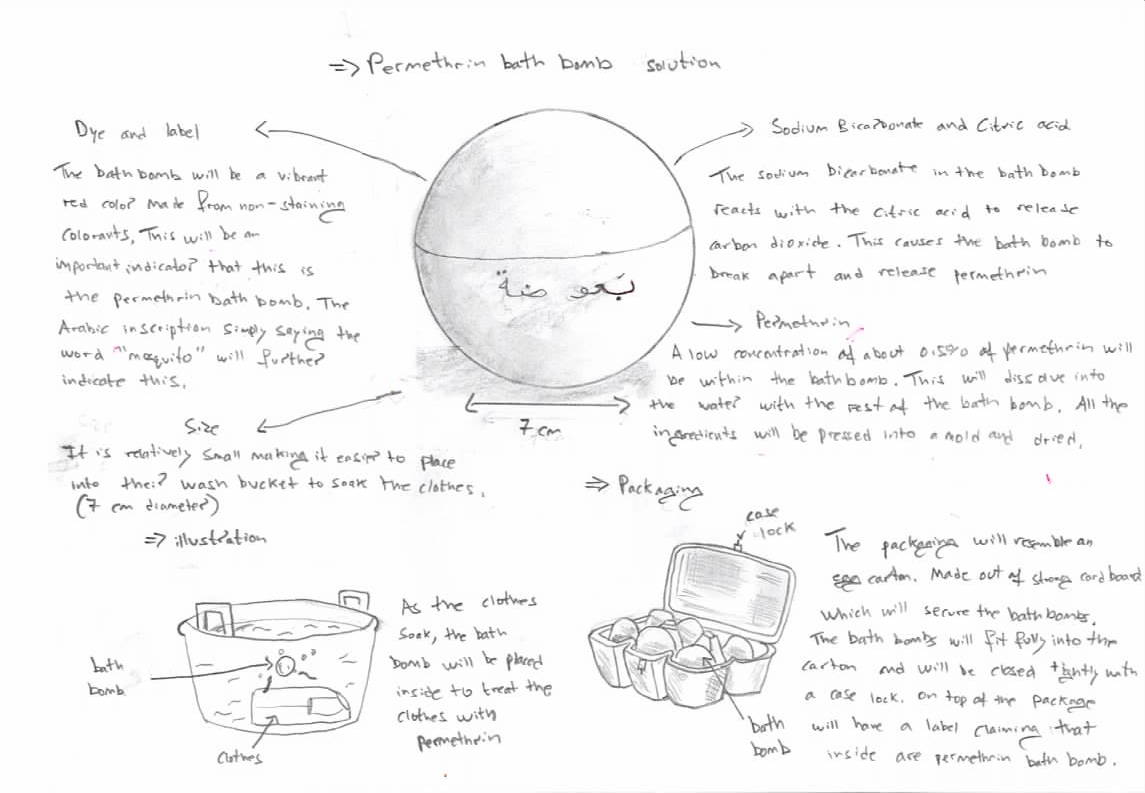This solution is a bath bomb containing the chemical permethrin.
Firstly, a bath bomb is a hard-packed mixture of ingredients which effervescence when it comes into contact with water and permethrin is a synthetic version of a chemical produced naturally by the chrysanthemum flower and is an insecticide. It is often put on clothes as a spray and it bonds to fabric killing ticks, mosquitoes, and insects that land on them.
This solution combines these two things to create a permethrin bath bomb. People would place this bath bomb into water, soak they clothes into the water and air the clothing. Once dry, the clothes will contain permethrin. The bath bombs would be distributed to people in small packets. With the bath bombs there will be reusable gloves and instructions on how to use the bath bombs. Furthermore, the education aspect will also include how to use the bath bombs and in community gathering areas, such as at local mosques, they can also discuss how to use these bath bombs. The information would include how many bath bombs to use, safety, how long to soak clothes for, etc.
Permethrin is the most effective chemical for this solution. Firstly, permethrin-treated clothes are still effective even after multiple washes. For example, a study illustrated that for the genus Aedes mosquitoes, that cause dengue, “the toxic effect of permethrin reduced biting rates by greater than 90% within the immediate area where subjects wore permethrin-treated uniforms for 9 hours.” (“The effectiveness of permethrin and deet, alone or in combination, for protection against Aedes taeniorhynchus,” 1984). This is ideal in Yemen as they are currently struggling with a water storage crisis and so cannot wash or treat their clothes with this chemical regularly so the long-lasting effect will benefit them greatly.
Furthermore, it is an inexpensive chemical. A large gallon cost between from 30 to 100 dollars. For example, a Martin’s Permethrin SFR Insecticide contains 36.8% of permethrin in 1.25 gallons. Thus, is not expensive to create small bath bombs. Moreover, the bath bombs will be diluted so it will not dangerous but still be effective, at most a 0.5% concentration.
Moreover, in terms of toxicity, Connecticut Department of Public Health, claimed that it “has low mammalian toxicity, is poorly absorbed through the skin, and is rapidly inactivated by the body… Skin reactions have been uncommon.” (Stafford C. K. III, 1999). Thus, the clothes would protect them without causing harm.
However, there are some limitations to this solution.
After using permethrin, the water must be discarded. This may pose a problem in Yemen, as the water is very scarce, and they may want to recycle it which would not be possible after using permethrin and so may decide simply not to use it. Furthermore, considering that Yemen is a very hot country the men and children may wear loose clothing or short sleeves making the solution ineffective as they will still be exposed to the mosquitoes. Moreover, although it is not toxic, the Environmental Protection Agency classifies it as a likely human carcinogen if consumed which may also pose some health risks. (“How Permethrin-treated Clothing Keeps You Safe”, 2018). Moreover, this will not only kill mosquitoes but also ticks and other insects which may cause harm to the ecosystem as untargeted organisms are being killed.
However, despite these limitations the solution is very simple, cheap and effective. Therefore, will be very beneficial in our particular context in Yemen.

References
Permethrin-Treated Clothing for Insect Protection. (2018, August 15). Retrieved April 24, 2019, from Modern Pest website: https://www.modernpest.com/blog/how-permethrin-treated-clothing-keeps-you-safe/
Schreck, C. E., Haile, D. G., & Kline, D. L. (1984). The effectiveness of permethrin and deet, alone or in combination, for protection against Aedes taeniorhynchus. The American Journal of Tropical Medicine and Hygiene, 33(4), 725–730.
Tick Bite Prevention. (2005, September 12). Retrieved April 24, 2019, from https://web.archive.org/web/20050912070432/http:/www.dph.state.ct.us/BCH/infectiousdise/tickborne/tick.htm#Permethrin
